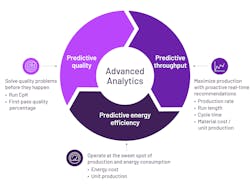Advancing waste reduction efforts with digital twins

As manufacturers scrutinize their operations through the lens of digital tools, improving process efficiency is a key goal. While there are many aspects to improving efficiency — such as maximizing throughput and minimizing resource consumption — some objectives can be more subtle. Reducing waste in manufacturing is a prime example.
Manufacturing waste results when production is off-specification and must be scrapped, which may occur in the middle of a production run, but is also likely to occur during startups and shutdowns. In some industries, scrap material can be reworked or re-used to an extent, but this ability almost always comes at a higher net cost than producing product correctly from the start.
Incorporating digital twins with advanced analytics helps manufacturers identify product quality deviations and associated waste-producing conditions, providing the insights needed to avoid or minimize waste.
Advanced analytics include using artificial intelligence (AI) with machine learning (ML) techniques, where models are built using contextualized historical data. The models then use real-time data from field assets and process variables, to generate insights into production deviations. Users can responsively take action, leading to improvements at scale for characteristics like product quality, throughput and minimized energy usage (Figure 1).
Users expect to leverage AI/ML capabilities with a no-code/low-code approach, often using wizard-based methods, so they can take advantage of the technology without requiring deep data science knowledge. But what do these considerations mean in the context of reducing waste? We will explore with an example.
Moving beyond the black book
One pet food manufacturer experienced significant processing waste during startup. The path from raw materials to finished product took almost an hour, requiring batching, mixing, compounding, grinding, extruding, drying, screening, coating and cooling the food. During cold startups, portions of the process were frequently off-specification, sometimes creating a cascade effect amplifying the problem throughout the process. Getting the production line into fully on-specification operation was a balancing act.
The operators, in proactive fashion, created a “black book,” documenting various startup conditions that frequently corresponded with success. However, the leadership team believed there was a better way, using a data-driven approach built on advanced/predictive analytics and a digital twin.
Connecting the process and people
While a digital twin can be used during a process design phase, the approach in this case was applied squarely in the operational production realm. Furthermore, the team committed that as they began taking these steps, they would not let mandates for “perfection” stand in the way of being “better” than historical human intervention.
Recognizing the results would only be as good as the source data, the team started by connecting to as many smart sensors and production line automation systems as possible. They leveraged AVEVA solutions to filter, cleanse and prepare the historical data, including associated lab results, in order to create an AI model for optimizing quality.
This off-the-shelf cloud-based AI solution uses real-time data for predicting product quality even before lab results are available, so it consistently makes timely process adjustment recommendations. People also remain in the loop because comprehensive situational awareness and visibility for users is imperative for evolving operational mindsets.
By the time the project was complete, operators accepted more than 80% of the AI-generated recommendations, and some actions proved so useful that they were integrated autonomously. As a result, the process capability index (CpK) — a measure of the production line’s ability to produce food within allowable standards — increased by nearly 30% through increased production output and reduced waste.
As this example shows, digital twins and advanced analytics can help process manufacturers reduce waste and enhance operational efficiency, driving business outcomes in both sustainability and profitability.
Petra Nieuwenhuizen has over 20 years of experience in IT and more than 10 years in the field of asset performance management, and she is a subject matter expert on asset strategies and analytics. She holds a special interest in digital twin and AI, and how companies can leverage their existing investments while connecting their data, people, processes and technology to exceed their reliability, safety and sustainability goals.
AVEVA
About the Author
Petra Nieuwenhuizen
Senior Product Marketing Manager, Asset Performance Management at AVEVA
Petra has over 20 years of experience in IT and more than 10 years in the field of asset performance management, and she is a subject matter expert on asset strategies and analytics. She holds a special interest in digital twin and AI, and how companies can leverage their existing investments while connecting their data, people, processes and technology to exceed their reliability, safety and sustainability goals.
